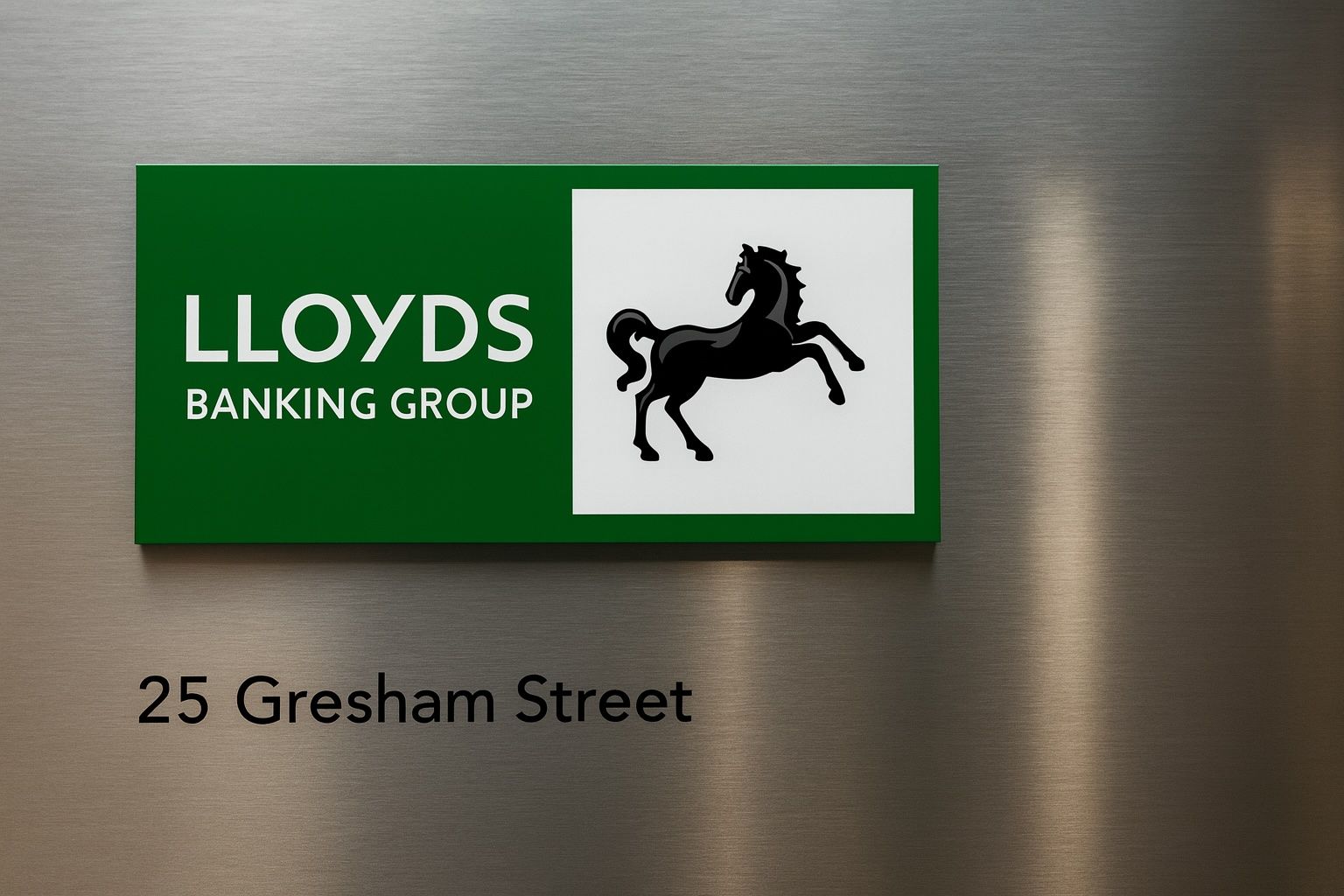- Share price surge: Lloyds Banking Group shares have risen more than 50 % since late‑2024 as higher interest rates boosted net interest income (NII) and investors cheered stronger earnings [1]. This rally has propelled the bank into the top tier of FTSE 100 performers and has led some commentators to question whether the stock is now fully valued [2].
- Analyst targets: City analysts have been chasing the rally. RBC Capital Markets has a price target around 95 p, Jefferies recently raised its target from 92 p to 103 p, and JPMorgan lifted its target to 98 p [3]. These targets imply a forward price‑to‑earnings (P/E) multiple of 11–14 in 2026 before falling to around 7.6 by 2027 if earnings grow as forecast [4].
- Wealth management gap: RBC analysts Benjamin Toms and Ben Bathurst argue that Lloyds’ wealth proposition is underdeveloped relative to UK peers and suggest the bank could bolster its position by acquiring asset manager Quilter. They note Lloyds exited wealth management after the PPI mis‑selling scandal but returned in 2019 via a partnership with Schroders that manages £17 bn but delivers lower net inflows than Schroders’ wider business [5]. The analysts estimate that buying Quilter for around £3.1 bn could make Lloyds the UK’s second‑largest wealth manager with almost £150 bn of assets [6].
- AI investments: The theoretical Quilter deal could deliver about 6 % earnings‑per‑share growth and an 11 % return on investment, but RBC warns integration would take time [7]. To ease integration bottlenecks, Lloyds has ramped up its artificial‑intelligence capability, creating a Centre for AI Excellence led by former Amazon executive Rohit Dhawan and sending 200 senior staff to a Cambridge University AI bootcamp [8].
- Dividend outlook: Dividend forecasts from City analysts look generous: the Motley Fool reports expected dividends of 3.58 p per share in 2025, 4.13 p in 2026 and 4.78 p in 2027, representing yields of 4.3 %, 5 % and 5.7 % respectively [9]. Payouts are projected to be covered more than twice by earnings, thanks to the bank’s robust balance‑sheet (CET1 ratio ~13.8 %) [10].
- Loan impairments and risks: Despite strong capital, loan impairments jumped to £442 m in the first half of 2025 from £100 m a year earlier [11]. Analysts warn that high inflation, a cooling labour market and stiff mortgage competition could erode profits [12].
- Institutional interest: Farther Finance Advisors and other institutional investors have been increasing stakes. Lloyds posted earnings per share of $0.14, beating the consensus by four cents, with return on equity around 9.28 % and net margin 17.5 % [13]. The bank pays a semi‑annual dividend of about $0.0655 per ADR, equating to a 3.7 %–4 % yield [14].
- AI adoption across finance: A Lloyds survey of senior financial leaders found over half plan to increase AI investment and more than 90 % now see the technology as an opportunity [15]. Productivity gains from AI adoption have jumped to 59 % from 32 % the previous year [16], but research suggests up to 10 % of banking jobs may disappear due to automation [17].
- Macro context: TS2.tech highlights a rebound in fintech funding in mid‑2025 and growing adoption of real‑time payments and digital wallets, but cautions that regulatory changes—such as new rules for ‘buy now, pay later’ lenders—add uncertainty [18]. Another TS2 piece notes gold and silver prices have surged to record levels in late‑2025 as investors seek safe‑haven assets amid expectations of US rate cuts and geopolitical turmoil [19]. These trends underscore investor nervousness about future economic growth.
Lloyds’ share price explosion: earnings power and rising valuations
Lloyds Banking Group (LSE: LLOY) has been one of the standout performers of the FTSE 100. The black‑horse bank’s share price climbed roughly 50 % in the 12 months to autumn 2025 as interest rates remained elevated and the UK economy avoided a deep recession [20]. High rates boost banks’ net interest income (NII)—the difference between what they earn on loans and pay on deposits—and Lloyds reported NII of £6.5 bn in the first half of 2025, a 5 % year‑on‑year increase [21].
The rally has left some investors wondering how much upside is left. Lloyds now trades around 13 times forecast 2025 earnings, making it one of the more expensive UK banks [22]. That partly explains why analysts’ price targets, while bullish, are still modest relative to the current price. RBC Capital Markets reiterates a 95 p target, while Jefferies and JPMorgan have raised theirs to 103 p and 98 p respectively [23]. If profits expand as forecast, the P/E ratio could compress to roughly 7.6 by 2027, according to Jefferies’ numbers [24].
Drivers of growth
Several factors underpin analysts’ optimism. First, net interest margins (NIM) are expected to rise from around 3.04 % in 2024 to 3.07 % in 2025, 3.26 % in 2026 and 3.37 % in 2027 [25]. Second, earnings per share are forecast to increase about 76 % between 2024 and 2027, helped by share buy‑backs of roughly £7.3 bn [26]. Third, analysts anticipate stable or rising dividends: Good Money Guide notes that the stock offered a forward yield above 4 % in 2025, and the consensus for 2026 implies a P/E of about 8.3, providing some headroom for further gains [27].
Yet there are risks. Higher borrowing costs can lead to more defaults, and Lloyds booked a £433 m loan impairment charge in 2024 with some analysts predicting it could rise to £1.38 bn by 2027 [28]. The bank is also vulnerable to potential windfall taxes or regulatory action if public pressure mounts over high profits [29]. Good Money Guide cautions that the share price might struggle to reach £1 in 2025 because the stock already trades on a P/E of around 11 and investors may book profits [30].
Forecasts and predictions
Independent forecasting site PoundF.co.uk predicts a steady climb for Lloyds shares. For October 2025 it sees a closing price of 87.15 p (a 4.5 % gain from early October), rising to 90.05 p by November and 93.83 p by December [31]. The site projects the price could reach 99.18 p by January 2026, 105.29 p in March and 122.41 p by June, closing 2026 near 139.87 p—a gain of 67 % over the year [32]. For 2027, it forecasts a peak of around 180 p in May before moderating later in the year [33]. While such projections should be treated cautiously, they illustrate the bullish sentiment around the stock.
Dividend outlook: higher payouts, but not without risk
Many investors buy Lloyds for income. Following the suspension of dividends during the pandemic, the bank has restored and steadily increased payouts. The Motley Fool cites analyst forecasts of 3.58 p per share in 2025, 4.13 p in 2026 and 4.78 p in 2027, representing dividend growth of 12.9 %, 15.4 % and 15.7 % respectively [34]. These payouts translate into yields of 4.3 %, 5 % and 5.7 %, well above the FTSE 100’s long‑term average [35].
Importantly, these dividends are expected to be covered 2.1 – 2.4 times by earnings, providing a cushion if profits falter [36]. The bank’s common equity tier 1 (CET1) ratio—the key measure of capital strength—stood at 13.8 % in mid‑2025 [37].
However, the outlook is not risk‑free. The same Motley Fool article warns that rising inflation and a weakening labour market could squeeze consumer demand and increase loan defaults. Lloyds’ loan impairments surged to £442 m in the first half of 2025 from £100 m a year earlier [38]. A slowdown in the housing market or more aggressive competition from challenger banks could undercut margins [39]. Investors chasing the high yield should therefore remain aware that dividends, though well‑covered today, are not guaranteed [40].
Wealth management ambitions and takeover talk
Lloyds has re‑entered the wealth‑management space only recently and is facing pressure to accelerate. After offloading its stake in St James’s Place as part of a post‑crisis simplification, the bank returned in 2019 through a joint venture with Schroders that oversees £17 bn of assets [41]. Yet the partnership’s net inflows average 2.6 %, roughly half that of Schroders’ overall business [42].
RBC’s Toms and Bathurst label Lloyds’ wealth proposition “underdeveloped” and argue that UK banks are generally “under‑penetrated” in wealth management because past scandals like PPI mis‑selling and the Retail Distribution Review forced them to retreat [43]. To close the gap, the analysts suggest Lloyds could terminate the Schroders tie‑up and buy Quilter. They estimate a price tag of £3.1 bn, which could be funded by excess capital and suspending share buy‑backs [44]. The acquisition would propel Lloyds to become the UK’s second‑biggest wealth manager with nearly £150 bn under management [45].
RBC notes that such a deal might deliver around 6 % earnings‑per‑share growth and an 11 % return on investment [46]. However, the gains would not materialise quickly; both firms would need to “grow into the relationship” and advisor capacity constraints could slow progress [47]. Interestingly, this is where Lloyds’ heavy investment in technology could pay off. The bank has built a Centre for AI Excellence headed by Rohit Dhawan and sent 200 senior staff to an AI bootcamp at Cambridge University [48]. These initiatives aim to automate administrative tasks and free advisors to focus on high‑value clients, potentially making a large acquisition more manageable.
Institutional interest and market sentiment
Farther Finance Advisors LLC recently increased its stake by 3,646 shares, according to DefenceWorld.net. Other institutional investors including Capital Research Global Investors and Vanguard hold significant positions [49]. In the second quarter of 2025, Lloyds reported earnings per share of $0.14, beating the consensus estimate of $0.10; revenue of $6.13 bn also exceeded expectations [50]. The bank offers a semi‑annual dividend of $0.0655 per ADR, equating to a yield of around 3.7 % [51]. Analyst ratings compiled by the site show a moderate‑buy consensus, though price targets range widely.
These numbers demonstrate that institutions continue to view Lloyds as a core holding. But they also reflect caution: return on equity was 9.28 %, respectable but not stellar, and the price‑book ratio of 0.80 suggests investors still apply a discount [52]. Any deterioration in asset quality or regulatory crackdown could quickly erode confidence.
AI adoption, fintech trends and the macro backdrop
Lloyds is not operating in isolation. The entire financial sector is undergoing a rapid technological transformation. A survey of more than 100 senior financial executives commissioned by Lloyds found over half plan to increase AI investment in the next 12 months, while another fifth will maintain current levels [53]. Over 90 % now view AI as an opportunity rather than a threat [54], and productivity gains from AI adoption have surged to 59 %, up from 32 % the previous year [55]. Yet automation has a dark side: research cited in the City AM report suggests up to 27,000 banking jobs could disappear as the sector cuts 178 m work hours over five years [56].
The broader fintech landscape also matters. TS2.tech notes that funding for fintech rebounded in mid‑2025 and adoption of real‑time payments and digital wallets accelerated, with the U.S. FedNow service processing 1.3 m transactions in Q1 2025, up 43 % quarter on quarter, and the European Payments Initiative integrating Wero wallet across borders [57]. Regulatory scrutiny is intensifying, however; the same article highlights the push to rein in buy now, pay later (BNPL) lenders and the uncertain impact of new rules [58]. In such a dynamic environment, Lloyds’ heavy investment in digital banking and AI could be a competitive advantage.
At the same time, risk‑averse investors have flocked to precious metals. Another TS2 article reports that gold prices surged to about $3,970 per ounce and silver hit a 14‑year high in October 2025 as expectations of U.S. rate cuts and geopolitical turmoil increased safe‑haven demand [59]. The rally underscores investor anxiety about macro‑economic stability; if growth slows or inflation proves sticky, bank profits could come under pressure.
Outlook: catalysts and cautionary tales
Looking ahead, the Lloyds share price story hinges on a delicate balance between positive catalysts and looming risks:
- Catalysts: persistent high interest rates, improving net interest margins, robust dividend growth, significant share buy‑backs, a possible wealth‑management acquisition, and cutting‑edge AI investments that may drive efficiency and scale.
- Risks: rising loan defaults, sensitivity to UK economic conditions, potential windfall taxes or stricter regulations, the complexity of integrating a large wealth acquisition, intensifying mortgage competition, and the social implications of workforce automation.
Analysts’ forecasts point to moderate upside, with price targets clustered around the mid‑90s to low‑100s pence and generous dividends continuing. Retail investors should consider whether the current valuation adequately compensates for the risks. The share price could climb further if the economy remains resilient and management executes on its strategic ambitions. But as the Motley Fool cautions, even well‑capitalised banks can suffer when the macro tide turns [60].
For now, Lloyds remains a bellwether of the UK banking sector. Its share price rally reflects both genuine improvements in profitability and an investor search for income in a world of persistent inflation. Whether it can maintain momentum may depend as much on the speed of technological change and macro‑economic shifts as on its own business decisions.
References
1. goodmoneyguide.com, 2. www.fool.co.uk, 3. www.fool.co.uk, 4. www.fool.co.uk, 5. www.cityam.com, 6. www.cityam.com, 7. www.cityam.com, 8. www.cityam.com, 9. www.fool.co.uk, 10. www.fool.co.uk, 11. www.fool.co.uk, 12. www.fool.co.uk, 13. www.defenseworld.net, 14. www.defenseworld.net, 15. www.cityam.com, 16. www.cityam.com, 17. www.cityam.com, 18. ts2.tech, 19. ts2.tech, 20. goodmoneyguide.com, 21. goodmoneyguide.com, 22. www.fool.co.uk, 23. www.fool.co.uk, 24. www.fool.co.uk, 25. www.fool.co.uk, 26. www.fool.co.uk, 27. goodmoneyguide.com, 28. www.fool.co.uk, 29. www.fool.co.uk, 30. goodmoneyguide.com, 31. poundf.co.uk, 32. poundf.co.uk, 33. poundf.co.uk, 34. www.fool.co.uk, 35. www.fool.co.uk, 36. www.fool.co.uk, 37. www.fool.co.uk, 38. www.fool.co.uk, 39. www.fool.co.uk, 40. www.fool.co.uk, 41. www.cityam.com, 42. www.cityam.com, 43. www.cityam.com, 44. www.cityam.com, 45. www.cityam.com, 46. www.cityam.com, 47. www.cityam.com, 48. www.cityam.com, 49. www.defenseworld.net, 50. www.defenseworld.net, 51. www.defenseworld.net, 52. www.defenseworld.net, 53. www.cityam.com, 54. www.cityam.com, 55. www.cityam.com, 56. www.cityam.com, 57. ts2.tech, 58. ts2.tech, 59. ts2.tech, 60. www.fool.co.uk










